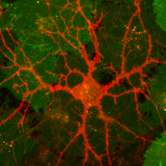The stress-induced mechanisms that cause our brain to produce feelings of fear in the absence of threats — such as in PTSD — have been mostly a mystery. Now, neurobiologists have identified the changes in brain biochemistry and mapped the neural circuitry that cause generalized fear experiences.
Tag: Neurotransmitter
Scientists reveal structures of neurotransmitter transporter
Scientists at St. Jude Children’s Research Hospital determined structures of a transporter protein involved in the movement of neurochemicals such as serotonin and dopamine, unearthing multiple mechanisms that can guide drug development.
Researchers discover how some brain cells transfer material to neurons in mice
A UC Davis study is the first to report on a material transfer mechanism from cells, known as oligodendrocytes, to neurons in the brain of a mouse model. This discovery opens new possibilities for understanding brain maturation and finding treatments for many neurological conditions.
Rare Human Gene Variant in ADHD, Autism Exposes Fundamental Sex Differences
Key differences in male and female mice brains provide new insights into how sex determines the mechanisms by which distinct synapses monitor and regulate dopamine signaling. The impact of sex differences is particularly pronounced when the mice express a human genetic variant found in boys with either ADHD or autism. Behavioral generalizations across the sexes may limit diagnosis of mental illness, especially if one sex translates alterations into outward signs such as hyperactivity and aggression vs. more internal manifestations such as learning, memory and mood, even when the same molecular pathology is at work.
Study Indicates Neurosurgical Procedure Used to Measure Dopamine and Serotonin Is Safe
Scientists at Wake Forest University School of Medicine have demonstrated that a neurosurgical procedure used to research and measure dopamine and serotonin in the human brain is safe.
Their findings are published online in PLOS One, a journal published by the Public Library of Science.
As science searches for answers on depression, what should patients do today?
Serotonin’s precise role in depression is getting attention because of a well-publicized new study, but SSRIs work for many people, as do other treatments. A depression expert explains why basic neuroscience research shouldn’t guide clinical decisions in real time.
‘Feel Good’ Brain Messenger Can Be Willfully Controlled, New Study Reveals
UC San Diego researchers and their colleagues have discovered that spontaneous impulses of dopamine, the neurological messenger known as the brain’s “feel good” chemical, occur in the brain of mice. The study found that mice can willfully manipulate these random dopamine pulses for reward.
Weizmann Institute Optogeneticists Use Mosquito Rhodopsins to Boost Brain Research
The Weizmann Institute’s Prof. Ofer Yizhar and colleagues used mosquito rhodopsins to create an optogenetics tool that is more precise, selective, and controllable than current techniques. In addition to increasing our understanding of the brain and advancing the field of optogenetics, the technology could lead to improved therapies for neurological and psychiatric conditions.
Researchers Develop New Minimally Invasive Method to Measuring Heart’s Neurotransmitter
Article title: Rapid measurement of cardiac neuropeptide dynamics by capacitive immunoprobe in the porcine heart Authors: Nicholas Kluge, Michael Joseph Dacey, Joseph Hadaya, Kalyanam Shivkumar, Shyue-An Chan, Jeffrey Laurence Ardell, Corey Smith From the authors: “Current methodologies for the measure…

Dopamine Surge Reveals How Even for Mice, ‘There’s No Place Like Home’
“There’s no place like home,” has its roots deep in the brain. Using fiber photometry, scientists are the first to show that home evokes a surge of dopamine in mice that mimics the response to a dose of cocaine. The study demonstrates how dopamine rises rapidly in mice moved from a simple recording chamber to their home cage, but less so when they return to a cage not quite like the one they knew.

New dopamine sensors could help unlock the mysteries of brain chemistry
In 2018, Tian Lab at UC Davis Health developed dLight1, a single fluorescent protein-based biosensor. This sensor allows high resolution, real-time imaging of the spatial and temporal release of dopamine in live animals. Now, the team expanded the color spectrum of dLight1 to YdLight1 and RdLight1. The increased light penetration and imaging depth of these variants provide enhanced dopamine signal quality allowing researchers to optically dissect dopamine’s release and model its effects on neural circuits.